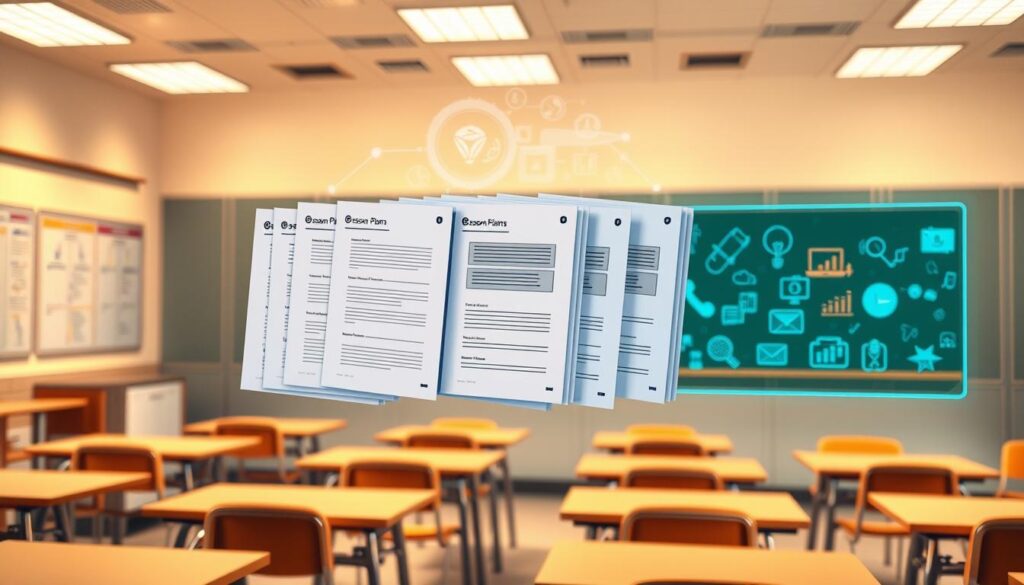Education is evolving fast, and AI tools like ChatGPT are transforming classrooms. Since 2022, this technology has grown into a powerful assistant, helping educators save time and boost student engagement. By 2025, it will be even smarter, offering personalized support for every teaching need.
Teachers can now automate lesson plans, create rubrics, and manage classrooms effortlessly. The AI handles repetitive tasks, giving educators more time to focus on their students. Whether it’s instant feedback or tailored learning paths, ChatGPT adapts to modern teaching demands.
This article covers nine key prompt categories, from lesson planning to group activities. You’ll also discover how platforms like Team-GPT enhance collaboration. Ready to streamline your workflow? Let’s dive in.
Key Takeaways
- ChatGPT reduces administrative tasks, freeing up time for educators.
- AI-driven prompts support personalized learning for students.
- Automated lesson planning and grading improve efficiency.
- Nine practical prompt categories simplify classroom management.
- Collaborative tools like Team-GPT integrate seamlessly with teaching workflows.
1. ChatGPT Prompts for Lesson Planning
Modern educators need smart tools to craft engaging lessons quickly. AI streamlines the process, turning hours of prep into minutes. Whether you’re designing a science unit or refining a history lecture, structured templates save time and boost consistency.

Generate Custom Lesson Plan Templates
Start with clear objectives. AI drafts a full framework—materials, procedures, and assessments—in seconds. For example, a photosynthesis lesson plan might include lab experiments and discussion questions. *Tailor prompts* like: “Outline a 45-minute session on [topic] with hands-on activities.”
Adapt Lessons for Different Grade Levels
One size doesn’t fit all. Simplify concepts for 3rd grade or add depth for high schoolers. Adjust vocabulary and complexity based on students’ needs. Use real-world examples, like comparing plant growth stages to age-appropriate analogies.
Create Time-Managed Activity Breakdowns
Pacing is key. AI splits a 50-minute class into segments: warm-up (5 min), instruction (15 min), group work (20 min), and wrap-up (10 min). Add buffer time for transitions. Backup activities keep momentum if tasks finish early.
“The best lessons adapt to the room’s energy—AI helps educators pivot seamlessly.”
2. ChatGPT Prompts for Writing Assistance
Clear communication is key in education, and AI tools help refine writing effortlessly. Whether polishing essays or adapting texts for younger students, technology streamlines the process. Here’s how to leverage it for maximum impact.

Proofread and Correct Grammar Instantly
AI detects errors in seconds, from misplaced commas to tense inconsistencies. Use prompts like “Fix grammatical mistakes in this passage” for quick edits. It also suggests improvements, such as replacing passive voice with active constructions.
Simplify Texts for Younger Students
Adjust vocabulary and sentence length for any grade level. For 3rd graders, AI shortens complex sentences and swaps advanced terms like “photosynthesis” with “how plants eat sunlight.” Try: “Rewrite this for a 5th-grade audience.”
Explain Idioms and Complex Phrases
Figurative language confuses many learners. AI breaks down idioms with literal translations and relatable examples:
| Idiom | Meaning | Student-Friendly Example |
|---|---|---|
| Bite the bullet | Endure hardship | “Like finishing homework before playing.” |
| Hit the sack | Go to bed | “Time to hit the sack like a sleepy bear.” |
“AI doesn’t just correct errors—it teaches better writing habits through consistent feedback.”
3. ChatGPT Prompts for Classroom Management
Effective classroom management sets the foundation for a productive learning environment. AI tools streamline rule-setting, behavior tracking, and conflict resolution, saving educators time while fostering student accountability.

Brainstorm Age-Appropriate Rules
Clear expectations prevent chaos. For 9th graders, AI generates rules like *”Respect peers’ opinions during discussions”* with consequences such as reflection sheets. Tailor prompts: “Create five rules for [grade] emphasizing teamwork and responsibility.”
Address Disruptive Behavior Strategies
Identify root causes—boredom, frustration, or attention-seeking. AI suggests:
- Positive reinforcement: Reward systems for on-task behavior.
- Non-verbal cues: Eye contact or proximity to redirect focus.
Example prompt: “Draft a parent letter about recurring tardiness with solutions.”
Mediate Student Conflicts
Plagiarism disputes or peer clashes resolve faster with AI scripts. Steps include:
- Listen to both sides without interruption.
- Identify common goals (e.g., fair collaboration).
- Agree on reparations, like revised work.
“Consistency in rules and empathy in conflict resolution build trust in the classroom.”
4. ChatGPT Prompts for Assignment Assessment
Streamlining assessment tasks with AI ensures fairness and saves valuable time. Educators can now generate detailed rubrics, guide peer evaluations, and enforce consistent late policies—all while maintaining high standards.

Craft Custom Grading Rubrics
AI builds rubrics with weighted criteria in seconds. For a science project, it might score content (40%), creativity (30%), and technical accuracy (30%). Use prompts like “Design a rubric for [assignment] assessing research depth and presentation clarity.”
Structure Peer Review Frameworks
Effective peer feedback requires clear guidelines. AI generates templates with:
- Specificity: “Highlight one strength and one area for improvement.”
- Positivity: “Start with constructive compliments before suggestions.”
Implement Late-Submission Policies
Automate fairness with tiered deductions (e.g., -2 points/day). AI drafts parent notifications explaining policy rationales. It also flags potential plagiarism by comparing writing styles across submissions.
“Transparent assessment criteria empower students to take ownership of their learning journey.”
This process reduces grading biases while providing actionable insights. Whether evaluating essays or group homework, technology ensures every student receives equitable treatment.
5. ChatGPT as a 24/7 Teaching Assistant
Education doesn’t stop when the bell rings—AI ensures continuous support. This technology bridges gaps for students who need help after hours or lack access to tutors. It adapts to individual learning paces, making education more inclusive.

Answer Student Questions After Hours
Late-night homework struggles? AI provides instant clarifications on algebra, history, or science. It breaks down complex topics like quantum physics into digestible steps. For ESL students, it rephrases explanations with simpler vocabulary.
- Customized support: Adjusts answers based on grade level or prior knowledge.
- Multilingual help: Translates concepts for non-native speakers.
- Safe access: Platforms like Team-GPT enable monitored interactions.
Provide Personalized Learning Support
Every student has unique needs. AI tailors responses for dyslexia or ADHD, using bullet points or analogies. Case studies show a 20% test score improvement when learners use it to review tough subjects.
“When tools meet students where they are, learning becomes a round-the-clock journey.”
Teachers save time by directing routine queries to AI, freeing up resources for deeper mentorship. Whether it’s a missed lecture or last-minute exam prep, assistance is always on.
6. ChatGPT Prompts for Student Engagement
Keeping students excited about learning requires fresh approaches—AI delivers dynamic solutions. Technology turns standard lessons into interactive activities that hold attention and improve retention. From historical simulations to math adventures, every subject becomes immersive.

Bringing Stories and History to Life
Role-playing transforms passive class sessions. Imagine debating scientific theories with Einstein or interviewing Shakespeare about sonnets. AI generates character backgrounds and dialogue examples, making literature and social studies tangible.
Try prompts like “Create a 10-minute play about the American Revolution from a loyalist’s perspective.” Students retain 40% more information when they actively participate rather than just listen.
Game-Based Learning That Feels Like Play
Gamification works because it taps into natural competitiveness. AI designs:
- Math scavenger hunts: Solve equations to unlock treasure map clues.
- Geography challenges: Guess countries from landmarks and cultural hints.
- Science escape rooms: Complete lab experiments to “disarm” a fictional virus.
“When kids beg to keep learning after the bell, you know engagement strategies are working.”
Track participation rates and quiz scores to measure success. These activities aren’t just fun—they reinforce concepts through repetition and application. Modern education thrives when students become eager explorers rather than passive listeners.
7. ChatGPT Prompts for Parent Communication
Strong parent-teacher partnerships drive student success—AI simplifies the connection. From progress reports to event coordination, technology ensures no school update falls through the cracks. Consistent touchpoints build trust and keep families engaged.

Automating Progress Updates
Weekly emails highlight individual achievements and growth areas. AI drafts personalized feedback like: “Alex mastered fractions but needs extra practice with word problems.” For homework trends, it flags recurring struggles (e.g., 60% of class missed question #3).
Streamlining Event Coordination
Never scramble to fill volunteer slots again. AI generates:
- Field trip reminders with packing lists and deadlines.
- Conference sign-up links synced to calendars.
- Multilingual resources for non-English-speaking families.
“When parents feel informed, they become active partners in their child’s education.”
Celebratory notes boost morale too. Try prompts like “Write a congratulatory message for a student who improved their reading level.” These small touches strengthen the school-home bond with minimal effort.
8. ChatGPT Prompts for Professional Development
Teaching excellence thrives on continuous improvement strategies. Modern education demands adaptable approaches, and AI provides personalized growth roadmaps. These tools analyze classroom interactions, suggest refinements, and even create training materials—all tailored to individual needs.

Generate Workshop Insights
AI crafts dynamic workshop agendas based on trending teaching challenges. It identifies knowledge gaps through classroom data and recommends relevant topics. Below are common workshop types with their benefits:
| Workshop Type | Focus Area | Sample Benefit |
|---|---|---|
| AI Integration | Technology | Reduces lesson planning time by 40% |
| Differentiated Instruction | Methods | Boosts engagement across learning styles |
| Classroom Analytics | Assessment | Identifies student progress patterns |
Improve Teaching Methods with Feedback
Constructive feedback transforms classrooms. AI helps by:
- Comparing lesson delivery styles against best practices
- Suggesting specific adjustments (e.g., “Add visual aids for kinesthetic learners”)
- Generating peer review templates with actionable improvement steps
Try this prompt: “Analyze my recorded lecture and suggest three engagement boosters.” The system evaluates pacing, questioning techniques, and student response rates.
“The most effective professional development happens daily—not just during annual training days.”
Platforms like Teachable integrate these insights seamlessly. Whether refining lesson plans or tracking student performance trends, AI makes growth an ongoing process rather than an event.
9. Conclusion
AI tools are reshaping modern education, making daily tasks easier for teachers and more engaging for students. From automated lesson plans to instant feedback, these solutions save hours while personalizing the learning experience.
Platforms like Team-GPT take collaboration further with organized folders and secure API controls. Imagine VR history lessons or AI-tailored IEPs—this is just the beginning.
Ready to transform your classroom? Try these strategies today and share your success stories. For more inspiration, explore resources like “AI Tools for Educators” or “Resume Writing with AI.” The future of teaching is here—embrace it.

